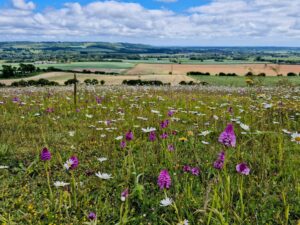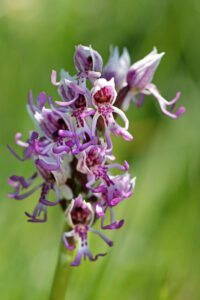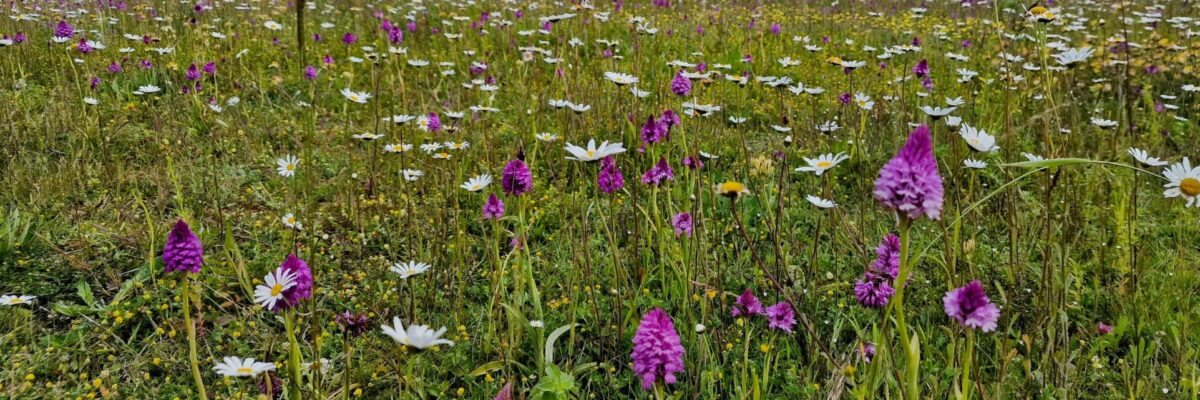Our Rare and Valuable Grasslands – Rachel Boot
13 February 2025
Support Officer Rachel Boot explores our wealth of grassland in Kent…
Have you ever seen a Kentish grassland in early summer? It’s a breathtaking sight – carpets of wildflowers and grasses, alive with bumblebees and butterflies; our species-rich grasslands pack a powerful punch for biodiversity. And in Kent, we are really spoilt for choice with our grassland types.

Photo: A view across a grassland in full bloom with Pyramidal orchids and Ox-Eye Daisies, in the Kent Downs
We are probably best known for our chalk grasslands, with 5000 hectares that straddle the county from West to East. Chalk grasslands host a really unique, dense assemblage of flora and fauna, and are home to some incredibly rare species, such as the Monkey Orchid and the Adonis Blue butterfly. Yet it’s a habitat on the verge of being wiped out, having declined by 97% globally in the last 70 years. Our Kentish chalk grasslands make up 5% of the total resource in the UK, which itself makes up 50% of the total chalk grassland globally. Continued efforts to protect and restore our chalk grassland in the county are vital, to safeguard this unique habitat type into the future.

Photo: A rare Monkey Orchid, found in only a few location in the UK, including on our chalk grassland in Kent
But it isn’t just chalk grassland that we have here – we also have a smaller resource of lowland meadow and acid grassland, which not only supports rare wild flowers, invertebrates, small mammals, reptiles and bird species, but also acts as important stepping stones for our wildlife, connecting adjoining habitats like hedgerows and woodlands, and allowing our biodiversity to move around – this is so important in allowing our more vulnerable species to breed, and to adapt to challenges like habitat destruction and climate change impacts.
When it comes to climate change, grasslands are one of the most resilient habitat types, and can cope impressively with extreme weather events like drought and flooding. They also play a valuable role in sequestering carbon, drawing it down from the atmosphere and locking it away in the soil for many years.
But these grassland types do have a central need in common – namely, sensitive management. As semi-natural habitats, they rely largely on low-intensity grazing practices, which produce a mix of sward lengths and exposed earth. The resulting mosaic of microhabitats allows a diverse range of species with varying needs to be supported, and, through managed grazing, stops encroachment from shrubs.
We’re not too far from Spring now, when our grasslands will be starting to bloom once again – make sure you get out and enjoy this beautiful habitat, and see if you can spot any of our rarer species!
You can also vote for your favourite grassland species in our flagship species activity, where we are trying to identify our ambassador species for the county! Vote here!
(Photo credit: Katie Pattison and Jim Higham)
Popular articles
Proposed approach for shortlisting priorities for nature recovery published
The Making Space for Nature project has been working with stakeholders to…
MS4N first milestone completed! Areas of importance for biodiversity mapped.
The MS4N project is delighted to have completed its first project milestone…
Haven’t been able to get to a workshop – you can still get involved!
There’s still one workshop of the pressures and priorities series left –…

